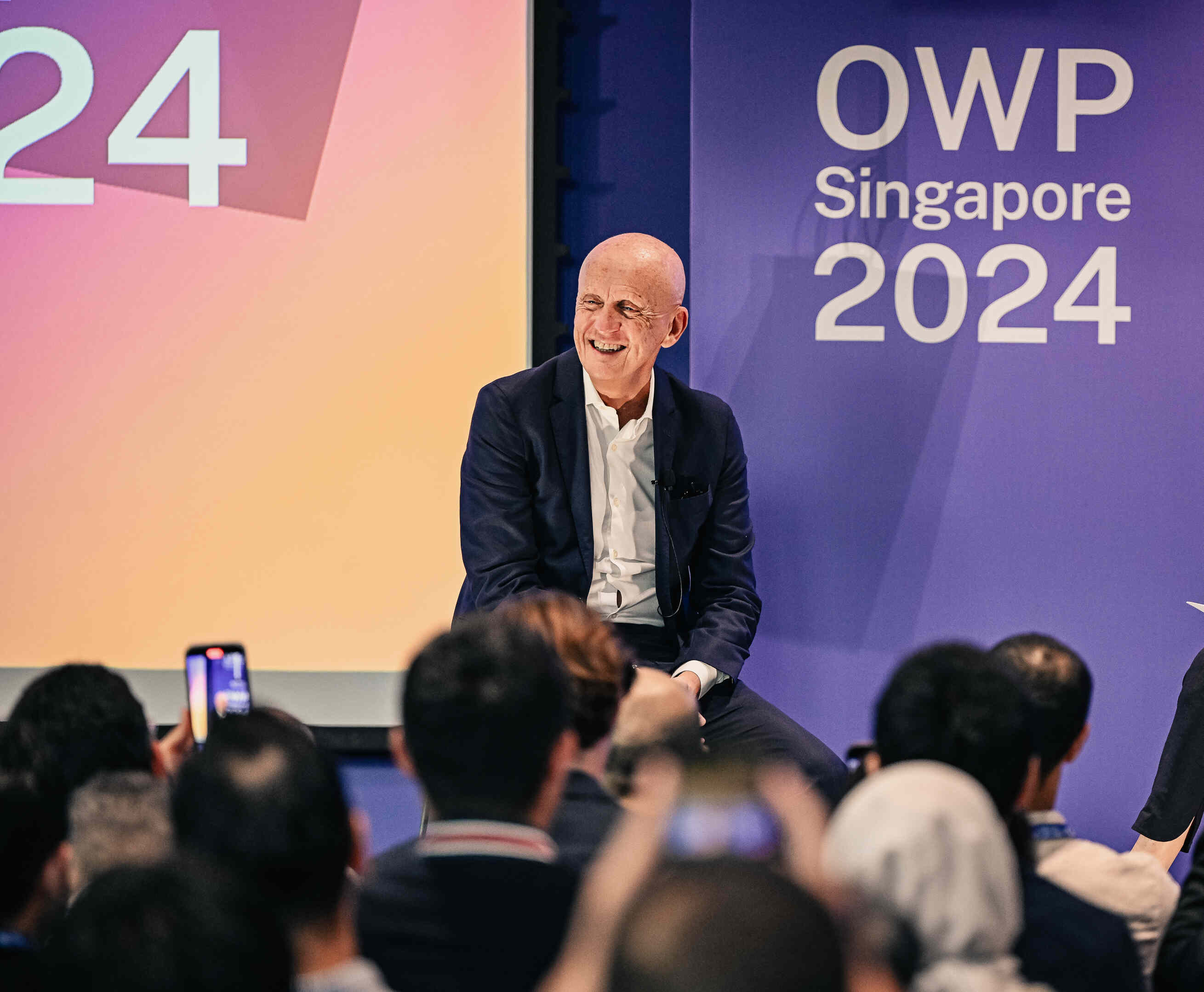More than 100 participants from around the world attended an IMD Discovery Event entitled Leadership Essentials. During the two-day event, Professor Preston Bottger offered his framework for Leadership Diagnostics, Influence and Energy.
If your actions inspire others to dream more, learn more, do more and become more, you are a leader.
John Quincy Adams
There are no two ways around it: Leadership is hard work. Yet, the actual tasks that are required of leaders are not always clear and there is no detailed plan of how to become a leader.
It is a well-known fact that companies need more leaders. We have all heard the famous statement in a meeting, “If I had 20 managers like X, I could go to the moon and back before lunch time.” So why is it that there are not more managers like X in the organization? The answer is simple: Managers choose not to become leaders.
As managers rise up through the ranks, they face several options about how to work within the organization, including whether they want to be seat-fillers or leaders.
Seat-fillers hold a position of comfort. They are only interested in filling their pockets and extending their circle of power. They are mostly concerned with how they can benefit from the people around them and the organization. They do not take any responsibilities beyond those initiatives that serve their personal objectives. Because seat-fillers are interested in comfort, they do not expend a lot of personal energy on creating value for the company and the people around them.
Leaders, by contrast, understand that they are responsible for other people’s lives, futures and money. They are willing to lead people in times of uncertainty and great challenge – constantly pushing them to go where they have never been before. Leaders help people to make investments to create a future that does not yet exist.
While many managers show signs of great leadership, leadership is not defined by a single moment in time. Leaders continuously need to ask themselves, “What is required of me? What new, good things can I create or introduce? What can I maintain or improve? What bad things can I fix or eliminate?”
So how can managers achieve this throughout their professional lives, not just during the initial weeks and months, but over a span of 10, 20, even 30 years? The ability not only to rise to a particular level but also to maintain this level every day over the lifetime of their careers is not just a key issue for leaders, it is the secret to great leadership.
What makes a successful leader?
When you look at someone in your organization who is 10 years further on in their career, what do you see? Are they tired, cynical, pessimistic? How did it happen? How can you avoid it happening to you? A pessimistic outlook will have a negative impact on others. Leaders should optimistically help people to create a successful future. Leadership is not a spectator sport. Leadership is doing what must be done and helping others to do the same. Too many people are busy doing other things – you need to think about your own theory of life and what is important to you.
When thinking about what is important to you, it is necessary to understand the relationships that you have with yourself, your family and your company. Take a moment to reflect on the relationships (deals) that you have with each and how they impact your daily life.
What relationships/deals do you have:
1. Between you and your company: At some point you must master the deal and ask for the resources you need to achieve stretch goals.
2. Between you and your family/friends:
3. With yourself?
As an aspiring leader, you should ask yourself how much responsibility you are prepared to take in terms of other people’s lives and other people’s money.
If you are going to take on the tremendous responsibility of leadership, you need to be sure you can answer these questions and, more specifically:
• How far do you want to go? Leaders need to understand the degree and kinds of effort that are required to take on such responsibilities. Are you willing to make yourself available to provide leadership to other people and accept increasing visibility if things go wrong?
• What are you willing to invest? Leaders face difficult choices about what they need to invest, and in which areas, to develop the capabilities necessary to take on extreme responsibility. What would you have to do as a leader that you don’t do now, or that you don’t enjoy doing? What do you enjoy now, but would have to give up?
• How will you keep it up? Leaders need to know how to nurture themselves, how to look after their own energy – their physical, emotional and intellectual freshness. Will you be able to galvanize your resources over the decades to come?
The Big 5 leadership arenas
In order to successfully organize and energize the work of the teams and units for which they are responsible, leaders require effective tools and methods. The following five essential tools can be implemented on a regular basis:
1. Communications: Conveying the big messages to orient people and focus them in the new imperatives – “what we are fighting for.” It is an ongoing campaign.
2. Mission: Attracting and engaging talented people to the project or enterprise and energizing all those involved, making them understand the importance of the mission from the big picture to the finer details.
3. Structure: Organizing the unit to deal with your new challenge. The right individuals and units know their roles and knit together.
4. Processes: Ensuring that vital activities are done to secure high-quality products and services with the most efficient use of time and assets.
5. Culture: Fostering an environment that is both respectful and open to dialogue and challenge, and in which all members of the organization feel “we are in this together.” Ensuring that the compensation scheme fully supports and encourages the right behaviors.
Leaders implement the firm’s business model by using f ive main tools or devices:
• Taking a strategic approach to influential COMMUNICATIONS
• Devising and selling the MISSION
• Designing and managing the STRUCTURE
• Designing and managing the PROCESSES
• Being a positive role model in the CULTURE
These tools are supported by the Diagnostics, Influence and Energy framework, three essential capabilities necessary for effective contributions in any leadership situation.
Diagnostics: Shaping your context
Leaders must recognize the critical opportunities and challenges that are being presented to them. How can they ensure that they are taking the right initiatives to improve wealth creation and reduce wasted efforts in the company’s business system – both for themselves and for the people for whom they are responsible?
As a leader, self-awareness is critical – you need a good theory of your own life. This involves coming to grips with your feelings, knowing what upsets you, learning to deal with criticism, resistance and setbacks and how to toughen up. Do you think that what has worked for you in the first half of your life will work as well in the second half?
An example of a leader with good diagnostic skills is Jamie Dimon, CEO of JP Morgan. Jamie has a top management team of 15 people who spend most of their time looking through data to understand what is going on in the market. In his meetings with his team, Jamie’s goal is to get to the right decisions for the company. It is not uncommon for Jamie’s team to challenge his ideas and tell him that he is wrong.
Influence: Managing your stakeholders
In order to successfully contribute to the company’s wealth-creating processes, leaders must have the capacity to influence. While leaders certainly have to influence individuals toward higher performance, they should also have a positive impact on groups of people. It is usually about mutual influence – one of the basics of teamwork. How do you get people who do not like one another excited about working together?
Energy: Galvanizing your resources
It goes without saying that one of the ways leaders energize others is through material rewards. Beyond this, however, high performance leaders motivate their people by selling them exciting missions that feature a powerful mix of: “never-done-that-before”; a major stretch in technical and political terms, but doable; and clear social and human benefits beyond economic value. For the implementers, this means receiving financial and career rewards that fully and fairly reflect the scale of the investors’ capital gains. All of this must be pervaded by a thrill of engagement stemming from the leader’s own vitality.
So the question to leaders is simple. How do you plan to maintain your intellectual, emotional and physical energy in order to inspire not only your co-workers for the next to 10 to 30 years but also yourself?
Intellectual curiosity is also important for long-term health. Research reports that people can delay Alzheimer’s and maintain effectiveness in old age by engaging in intellectual activities today. Negative emotional energy is harmful not only to you but also to your organization. Reducing stress is key to well-being. As a leader, you need to learn how to manage your time properly by creating a schedule that works for you and gives you a sense of control. Stress, depression and anxiety are among the main reasons for days missed in the workplace.
Physical energy is crucial to overall performance. You need to know how to look after yourself, for example getting proper sleep, nutrition and exercise. Physical energy impacts business every year. In the US, for example, over $3.6 billion is lost every day to sick days taken due to physical illness.
Summary
In order to achieve these goals, managers need to identify and develop their own personal leadership model based on the framework of the Big 5 tools and Diagnostics, Influence and Energy (see participants’ roadmaps below).
So leaders must prepare to be energetically ingenious in all aspects of their work, every day, for many years to come.





